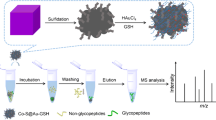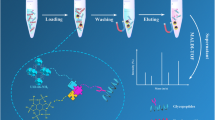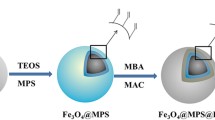Abstract
Protein glycosylation is one of the most important post-translational modifications. Also, efficient enrichment and separation of glycopeptides from complex samples are crucial for the thorough analysis of glycosylation. Developing novel hydrophilic materials with facile and easily popularized synthesis is an urgent need in large-scale glycoproteomics research. Herein, for the first time, a one-step functionalization strategy based on metal-organic coordination was proposed and Fe3O4 nanoparticles were directly functionalized with zwitterionic hydrophilic l-cysteine (L-Cys), greatly simplifying the synthetic procedure. The easily synthesized Fe3O4/L-Cys possessed excellent hydrophilicity and brief composition, contributing to affinity for glycopeptides and reduction in nonspecific interaction. Thus, Fe3O4/L-Cys nanoparticles showed outstanding sensitivity (25 amol/μL), high selectivity (mixture of bovine serum albumin and horseradish peroxidase tryptic digests at a mass ratio of 100:1), good reusability (five repeated times), and stability (room temperature storage of 1 month). Encouragingly, in the glycosylation analysis of human serum, a total of 376 glycopeptides with 393 N-glycosylation sites corresponding to 118 glycoproteins were identified after enrichment with Fe3O4/L-Cys, which was superior to ever reported L-Cys modified magnetic materials. Furthermore, applying the one-step functionalization strategy, cysteamine and glutathione respectively direct-functionalized Fe3O4 nanoparticles were successfully synthesized and also achieved efficient glycopeptide enrichment in human serum. The results indicated that we have presented an efficient and easily popularized strategy in glycoproteomics as well as in the synthesis of novel materials.

Fe3O4/L-Cys nanoparticles based on one-step functionalization for highly efficient enrichment of glycopeptides.






Similar content being viewed by others
References
Mechref Y, Muddiman DC. Recent advances in glycomics, glycoproteomics and allied topics. Anal Bioanal Chem. 2016;409(2):355–7.
Palaniappan KK, Bertozzi CR. Chemical glycoproteomics. Chem Rev. 2016;116(23):14277–306.
Kailemia MJ, Park D, Lebrilla CB. Glycans and glycoproteins as specific biomarkers for cancer. Anal Bioanal Chem. 2016;409(2):395–410.
Ding W, Hill JJ, Kelly J. Selective enrichment of glycopeptides from glycoprotein digests using ion-pairing normal-phase liquid chromatography. Anal Chem. 2007;79(23):8891–9.
Chen CC, Su WC, Huang BY, Chen YJ, Tai HC, Obena RP. Interaction modes and approaches to glycopeptide and glycoprotein enrichment. Analyst. 2014;139(4):688–704.
Lin H, Ou J, Zhang Z, Dong J, Wu M, Zou H. Facile preparation of zwitterionic organic-silica hybrid monolithic capillary column with an improved "one-pot" approach for hydrophilic-interaction liquid chromatography (HILIC). Anal Chem. 2012;84(6):2721–8.
Shen A, Guo Z, Yu L, Cao L, Liang X. A novel zwitterionic HILIC stationary phase based on "thiol-ene" click chemistry between cysteine and vinyl silica. Chem Commun. 2011;47(15):4550–2.
Cao W, Huang J, Jiang B, Xing G, Yang P. Highly selective enrichment of glycopeptides based on zwitterionically functionalized soluble nanopolymers. Sci Rep. 2016;6:29776.
Chen Y, Xiong Z, Zhang L, Zhao J, Zhang Q, Peng L, et al. Facile synthesis of zwitterionic polymer-coated core-shell magnetic nanoparticles for highly specific capture of N-linked glycopeptides. Nano. 2015;7(7):3100–8.
Yeh CH, Chen SH, Li DT, Lin HP, Huang HJ, Chang CI, et al. Magnetic bead-based hydrophilic interaction liquid chromatography for glycopeptide enrichments. J Chromatogr A. 2012;1224:70–8.
Jiang B, Wu Q, Deng N, Chen Y, Zhang L, Liang Z, et al. Hydrophilic GO/Fe3O4/Au/PEG nanocomposites for highly selective enrichment of glycopeptides. Nano. 2016;8(9):4894–7.
Sun S, Yang G, Wang T, Wang Q, Chen C, Li Z. Isolation of N-linked glycopeptides by hydrazine-functionalized magnetic particles. Anal Bioanal Chem. 2010;396(8):3071–8.
Fratila RM, Moros M, de la Fuente JM. Recent advances in biosensing using magnetic glyconanoparticles. Anal Bioanal Chem. 2016;408(7):1783–803.
Bi C, Zhao Y, Shen L, Zhang K, He X, Chen L, et al. Click synthesis of hydrophilic maltose-functionalized iron oxide magnetic nanoparticles based on dopamine anchors for highly selective enrichment of glycopeptides. ACS Appl Mater Interfaces. 2015;7(44):24670–8.
Zhang S, He X, Chen L, Zhang Y. Boronic acid functionalized magnetic nanoparticles via thiol-ene click chemistry for selective enrichment of glycoproteins. New J Chem. 2014;38:4212–8.
Uehara J, Aramaki K. A surface-enhanced Raman spectroscopy study on adsorption of some sulfur-containing corrosion inhibitors on iron in hydrochloric acid solutions. J Electrochem Soc. 1991;138(11):3245–51.
Wang G, Harrison A, Li X, Whittaker G, Shi J, Wang X, et al. Study of the adsorption of benzimidazole and 2-mercaptobenzothiazole on an iron surface by confocal micro-raman spectroscopy. J Raman Spectrosc. 2004;35:1016–22.
Deng H, Li X, Peng Q, Wang X, Chen J, Li Y. Monodisperse magnetic single-crystal ferrite microspheres. Angew Chem Int Ed. 2005;44(18):2782–5.
Wang J, Wang Y, Gao M, Zhang X, Yang P. Versatile metal-organic framework-functionalized magnetic graphene nanoporous composites: as deft matrix for high-effective extraction and purification of the N-linked glycans. Anal Chim Acta. 2016;932:41–8.
Wu R, Li L, Deng C. Highly efficient and selective enrichment of glycopeptides using easily synthesized magG/PDA/Au/L-Cys composites. Proteomics. 2016;16(9):1311–20.
Sun X, Zhang L, Zhang W. Preparation of cysteine-click maltose modified silica as a hydrophilic interaction liquid chromatography material for the enrichment of glycopeptides. Chin J Chromatogr. 2017;35(7):696–702.
Sun X, Dong J, Li J, Ye M, Ou J, Zhang L, et al. Au-cysteine modified macroporous adsorption resin: preparation and highly selective enrichment and identification of N-linked glycopeptides from the complex biological sample. RSC Adv. 2016;6:113058–65.
Zheng J, Xiao Y, Wang L, Lin Z, Yang H, Zhang L, et al. Click synthesis of glucose-functionalized hydrophilic magnetic mesoporous nanoparticles for highly selective enrichment of glycopeptides and glycans. J Chromatogr A. 2014;1358:29–38.
Kuo CW, Wu IL, Hsiao HH, Khoo KH. Rapid glycopeptide enrichment and N-glycosylation site mapping strategies based on amine-functionalized magnetic nanoparticles. Anal Bioanal Chem. 2012;402(9):2765–76.
Wang J, Li J, Wang Y, Gao M, Zhang X, Yang P. Development of versatile metal-organic framework functionalized magnetic graphene core-shell biocomposite for highly specific recognition of glycopeptides. ACS Appl Mater Interfaces. 2016;8(41):27482–9.
Wu R, Xie Y, Deng C. Thiol-ene click synthesis of L-cysteine-bonded zwitterionic hydrophilic magnetic nanoparticles for selective and efficient enrichment of glycopeptides. Talanta. 2016;160:461–9.
Acknowledgements
This work was supported by China State Key Research Grant (Project 2016YFA0501402) and National High-Tech R&D Program of China (Project 2012AA020202).
Authors’ contributions.
All authors have given approval to the final version of the manuscript.
Author information
Authors and Affiliations
Corresponding author
Ethics declarations
The authors declare that they have no conflict of interest. The research followed the tenets of the Declaration of Helsinki, and the use of the human serum samples for research was approved by the Ethics Committee of Zhongshan Hospital, Fudan University. Informed consent was obtained from all individual participants included in the research.
Additional information
Published in the topical collection celebrating ABCs 16th Anniversary.
Electronic supplementary material
ESM 1
(PDF 2.06 MB)
Rights and permissions
About this article
Cite this article
Feng, X., Deng, C., Gao, M. et al. Facile and easily popularized synthesis of l-cysteine-functionalized magnetic nanoparticles based on one-step functionalization for highly efficient enrichment of glycopeptides. Anal Bioanal Chem 410, 989–998 (2018). https://doi.org/10.1007/s00216-017-0602-5
Received:
Revised:
Accepted:
Published:
Issue Date:
DOI: https://doi.org/10.1007/s00216-017-0602-5




